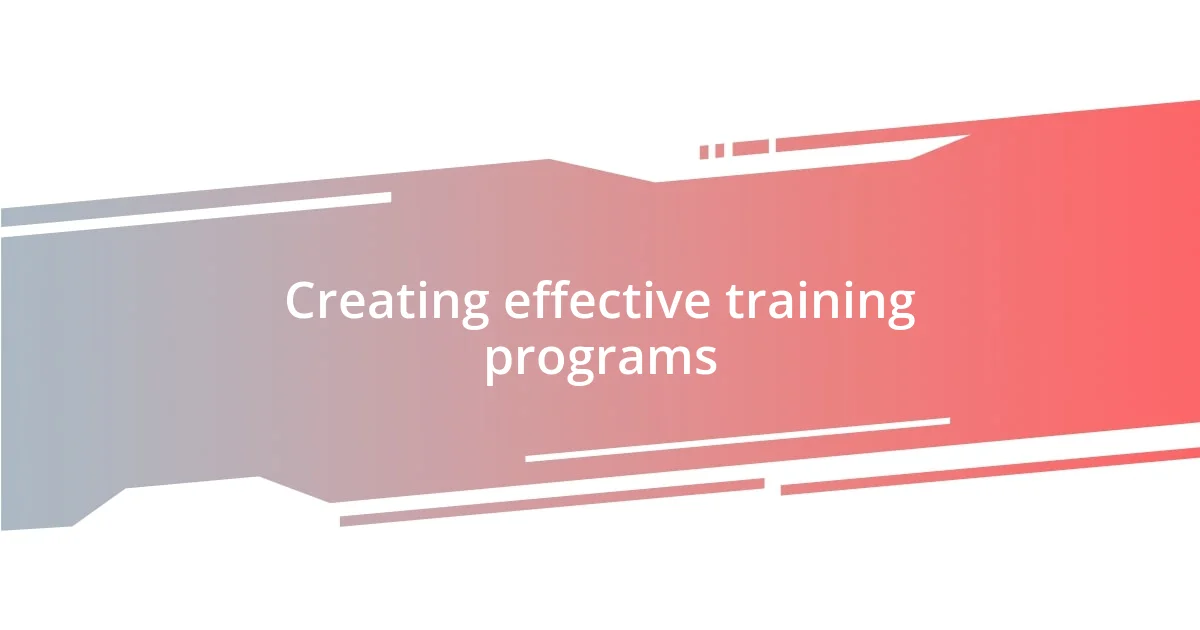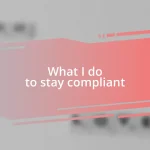Key takeaways:
- Engaging team members in compliance through open dialogue and collaboration fosters ownership and transforms compliance into a shared responsibility.
- Creating effective training programs tailored to the team’s diverse learning styles and incorporating storytelling enhances retention and real-world understanding of compliance.
- Celebrating compliance successes, no matter how small, boosts team morale and reinforces the idea that compliance is integral to the team’s collective growth and integrity.

Understanding compliance culture
Understanding compliance culture is like navigating a shared journey where everyone feels responsible for the organization’s ethical compass. I remember when I first encountered resistance from my team regarding compliance measures, and it struck me: how could we foster a culture if not everyone felt included? This realization propelled me to rethink our approach and involve everyone in discussions around compliance.
When I think about compliance culture, I often wonder: why do some teams embrace it, while others resist? In my experience, it boils down to trust and open communication. I recall when we held a workshop inviting everyone to voice their concerns and ideas; the atmosphere shifted dramatically. Suddenly, compliance wasn’t just a set of rules—it became a shared responsibility and a source of pride for the team.
A robust compliance culture thrives on collaboration, where team members don’t see compliance as a burden but rather as a foundation for their work. For example, I used to feel overwhelmed by regulatory requirements, but as we tackled them together as a team, that weight transformed into a shared mission. How often do we miss opportunities to engage our colleagues in these discussions, ultimately shaping a supportive environment?

Identifying team compliance needs
Identifying the compliance needs of your team is a crucial first step. I remember when I conducted a simple survey to gather feedback from my colleagues about their understanding of compliance issues. What surprised me was how different everyone’s perceptions were; some felt overwhelmed, while others didn’t see the relevance at all. This eye-opener reminded me that compliance isn’t a one-size-fits-all concept—each team member brings their unique perspective that needs to be acknowledged.
As I dived deeper into my team’s specific compliance requirements, I realized the importance of open dialogue. I began hosting regular check-ins, encouraging my team to discuss compliance challenges that they faced in their roles. These conversations not only illuminated our compliance gaps but also fostered an environment where everyone felt empowered to contribute. I found that when people feel heard, they become more engaged in finding solutions.
Talking to my colleagues also revealed the emotional aspect behind compliance needs. Many shared fears of making mistakes or facing repercussions. It became clear that compliance was not solely about following rules; it was about feeling secure in one’s role. I learned to approach compliance needs with empathy, creating a safe space for discussions.
| Team Member | Compliance Need |
|---|---|
| Alice | Clear guidelines on data protection |
| Bob | Regular updates on regulatory changes |
| Charlie | Training sessions on compliance procedures |

Engaging team members in compliance
When it comes to engaging team members in compliance, I’ve found that creating a sense of ownership is key. I recall a team brainstorming session where we collectively designed our compliance training program. This experience not only empowered individuals but also sparked enthusiasm. Suddenly, compliance was no longer a chore; it was a collaborative endeavor everyone wanted to champion.
One effective strategy I’ve employed is encouraging peer-led discussions, fostering an atmosphere of shared learning. This bolsters team bonding while addressing compliance nuances. Here are some practical steps I’ve taken:
- Involve team members in creating compliance materials: When I allowed my team to contribute, they felt a sense of pride and accountability.
- Implement feedback loops: Regularly solicit insights on compliance processes to actively demonstrate that each voice matters.
- Use real-life scenarios: Sharing past compliance challenges helped the team see the implications of their actions in a relatable context.
- Celebrate compliance achievements: Recognizing efforts, no matter how small, motivates and reinforces the positive contributions team members make to our compliance culture.
This approach has significantly enhanced our team’s engagement, making compliance a shared narrative rather than a set of isolated mandates.

Creating effective training programs
Creating effective training programs requires a keen understanding of your team’s unique needs and learning styles. For instance, I once organized a training session that combined various formats—workshops, e-learning modules, and open discussions. It was fascinating to see the diversity in how team members engaged with the materials. Some thrived in hands-on workshops, while others preferred the flexibility of online resources. Tailoring the approach allowed everyone to find a comfortable way to absorb vital compliance information.
Additionally, incorporating storytelling into the training programs made a significant impact on retention. I often share personal experiences related to compliance challenges I’ve faced—these stories seem to resonate deeply with my team. When discussing a past incident where a misunderstanding of regulations led to a costly error, I could feel the room shift. Suddenly, compliance transformed from a dry set of rules into a real-world situation with tangible consequences. This emotional connection not only heightened their interest but also made the lessons far more memorable.
Regular feedback is essential for refining training programs, and I’ve discovered that fostering an environment where team members feel safe to voice their thoughts can be a game changer. Early on, after one of my training sessions, I asked for feedback in a casual setting, perhaps over coffee. The honesty that followed was surprising. One of my teammates mentioned that the pacing was too fast for some participants. This input led me to adjust future sessions, including additional Q&A time. How often do we overlook the valuable insights our team can provide? By actively seeking feedback, I realized we could continually evolve our training initiatives and better support each other’s growth.

Establishing clear compliance policies
Establishing clear compliance policies has been pivotal in fostering a culture of accountability. I remember when we first rolled out our compliance guidelines; the team was unsure and somewhat skeptical. To ease their concerns, I held an informal lunch meeting to walk through the policies together, ensuring that everyone understood the rationale behind each rule. It was an approach that transformed confusion into clarity, allowing my team to see compliance as a supportive framework rather than a constraint.
I made a conscious effort to keep the language in our compliance documentation straightforward and relatable. One time, I simplified a particularly complex regulation by creating a one-page summary with bullet points and relatable examples. The feedback was overwhelmingly positive—people expressed how much easier it was to grasp the key points! Isn’t it amazing how a little clarity can lead to greater compliance?
To further reinforce these policies, I initiated regular check-ins to discuss how they were being applied in our day-to-day work. During one of these sessions, a team member shared an innovative workaround that balanced compliance with efficiency. It was moments like these that reminded me of the importance of keeping an open dialogue. How have you encouraged your own team to actively engage with compliance guidelines? I believe that fostering this type of collaboration not only strengthens the policies but also enhances team morale and trust.

Monitoring and evaluating compliance
Monitoring compliance is a continual process that requires both oversight and feedback. Personally, I found that regular compliance audits were vital in identifying gaps in understanding or execution. During one audit, we uncovered that a few team members were unclear about specific procedures, which led to unnecessary delays in our workflow. This experience highlighted the importance of not just monitoring, but also translating those findings into actionable improvements.
I also implemented a system for anonymous reporting, which empowered team members to share their concerns without fear of repercussions. Once, a team member approached me after submitting a concern anonymously about an unwritten practice that was causing inconsistencies. This revelation was a turning point for us. It reinforced the idea that monitoring compliance isn’t just about finding faults but creating an environment where everyone feels valued and heard.
Evaluating compliance goes beyond just tracking errors; it’s about fostering growth. After we established some key metrics, I made it a point to celebrate compliance successes in team meetings. I vividly recall the pride that radiated through the room when we reviewed a significant reduction in compliance-related issues over a quarter. This not only motivated the team but also showcased that our efforts in monitoring were genuinely making a difference. How do you celebrate compliance wins in your team? I’ve learned that recognition can be a powerful motivator, encouraging everyone to stay engaged and committed to our compliance culture.

Celebrating compliance successes
Celebrating compliance successes has become a cornerstone of our team culture. I vividly remember when we achieved our first quarter with zero compliance breaches. I organized a small celebration, complete with cupcakes and team shout-outs. The excitement was palpable! It was more than just a sweet treat—it reinforced the notion that compliance is a shared victory. Have you ever witnessed a moment like that in your own team? It can truly transform the way people view their contributions.
In another instance, after noticing significant improvements in our documentation practices, I decided to highlight individual efforts during our monthly meetings. Each person who made a difference received a shout-out and a little gift—just a token of appreciation, but you should have seen the smiles! Celebrating these small wins instilled a sense of pride and encouraged others to follow suit. I’ve learned that recognizing efforts fosters a thriving compliance environment. When was the last time you recognized someone for their compliance achievements?
These celebrations don’t just boost morale; they also serve as powerful reminders of our collective commitment to compliance. When we take the time to acknowledge these successes, it solidifies the idea that compliance is not just a set of rules but a pathway to our team’s growth and integrity. Personally, I find it deeply rewarding to witness how these moments energize the team, motivating us all to uphold and enhance our compliance culture. What strategies have you found effective in celebrating compliance milestones?















